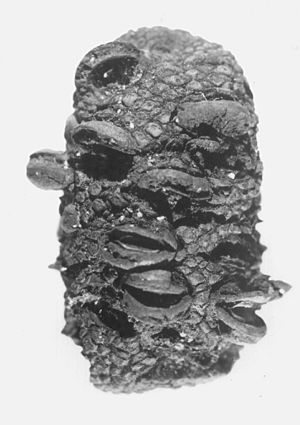Banksia kingii facts for kids
Quick facts for kids Banksia kingiiTemporal range: Late Pleistocene
|
|
|---|---|
 |
|
| Banksia kingii fossil cone |
|
| Scientific classification | |
| Kingdom: | |
| (unranked): | |
| (unranked): | |
| Order: | |
| Family: | |
| Genus: | |
| Subgenus: | |
| Section: | |
| Series: | |
| Species: |
B. kingii
|
| Binomial name | |
| Banksia kingii Jordan & Hill
|
|
Banksia kingii is an amazing plant that lived a long, long time ago. It's now extinct, meaning it no longer exists on Earth. We know about it from its fossils, which are like ancient plant remains. Scientists found its leaves and seed cones preserved in rocks in a place called Melaleuca Inlet in western Tasmania, Australia.
This plant lived during the Late Pleistocene epoch. That was a very long time ago, when giant animals like mammoths roamed the Earth! The climate where Banksia kingii lived was likely cool, maybe even cooler than it is in Melaleuca today. It might have been a very wet place too, with lots of rain.
Contents
Discovering an Ancient Plant
The fossils of Banksia kingii were found by a man named Deny King. He was a tin miner in Tasmania. He discovered these ancient plant parts while working in his mine.
The fossil leaves and seed cones were found in different spots. Because the ground had been dug up for mining, scientists don't know exactly how deep or in what order the fossils were originally buried. The soil they were found in was made of alluvium, which means it was carried there by water. It contained large, rounded pieces of quartz and schist rock.
What Did Banksia kingii Look Like?
Scientists studied the fossil leaves and seed cones very carefully.
The Leaves
The fossil leaves are about 12 centimetres (almost 5 inches) long. They are also about one centimetre (less than half an inch) wide. These leaves were very thick and strong. They clearly belong to the Banksia plant group.
The leaves of Banksia kingii are similar to some modern Banksia species. For example, they look a bit like the leaves of Dallachy's Banksia in their shape and strength. However, their internal structure is quite different. The leaves of Grampians Banksia have a similar internal structure, but their shape is not the same. There are also some similarities to Silver Banksia and Mountain Banksia. But the differences were big enough for scientists to decide that these fossils were from a brand new, unknown species. That's why they named it Banksia kingii.
The Seed Cones
The fossil seed cones are shaped like cylinders. They are about 6 centimetres (about 2.4 inches) tall and 4.5 centimetres (about 1.8 inches) wide. These cones had already lost their old flower parts.
The seed cones of Banksia kingii seem most closely related to those of Banksia saxicola and Banksia canei. They also share some features with Banksia marginata. Since both the leaves and the cones show similar relationships to other Banksia species, scientists believe they all belong to Banksia kingii, even though they weren't found together.
Why Did Banksia kingii Disappear?
Scientists believe Banksia kingii represents a plant family that no longer exists. It's possible that it was an ancestor of Banksia marginata, a species that is very common today. However, Banksia marginata must have developed into its own species long before Banksia kingii died out.
Banksia kingii likely became extinct in the late Quaternary period. This was a time of big changes on Earth. Its extinction might have been caused by glaciation, which means huge ice sheets covered parts of the world. This would have changed the climate and landscape a lot. Another possible reason is an increase in bushfires, perhaps caused by early human activity in the area.
Naming the Species
The formal description of Banksia kingii was published in 1991. Two scientists, Gregory J. Jordan and Robert S. Hill, wrote about it. They named the species in honour of Deny King, the person who discovered the fossils. So, the full scientific name is "Banksia kingii Jordan & Hill".
The original fossil specimens, including the main one called the holotype, are kept safe. You can find them in the Department of Plant Science at the University of Tasmania.


